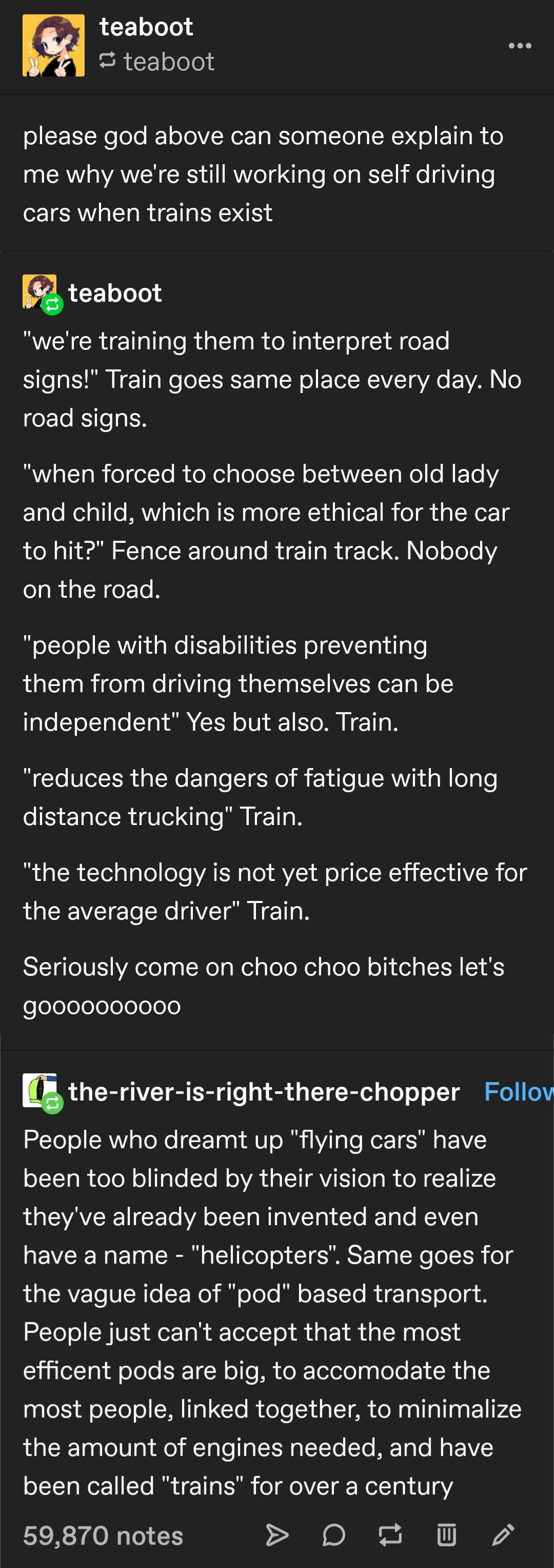Originally published at: https://boingboing.net/2024/03/19/are-you-ready-for-four-color-traffic-lights.html
…
If the plan requires tremendous changes to both human behavior and the way cars themselves work in order to be an improvement over the status quo, why not just put all that energy into designing more human-friendly cities, roadways and intersections?
We don’t need to find ways to move more cars through every intersection, we need to build cities around the idea that people should have better options for getting around cities than driving everywhere.
In Greater Toronto, we already have a white light at some intersections. It’s a go for buses/streetcars waiting in the inner transit lanes if they’re making a turn. It’s separate from the red-yellow-green to avoid confusing car drivers, who get a red during this.
I have red-green color blindness and the ‘green’ light appears to me already as a pale white. Two white lights? No thank you.
Yup. This is pretty common. Round here it’s usually not just a plain white light, but something from a set of symbols the bus drivers are trained to read.
white lights tell human drivers to simply follow the car in front of them. In short, the white light is a signal that AVs are coordinating their movement to facilitate traffic through the intersection more efficiently.
Yet how many “human drivers” are to follow the robot car? It’s sorry(?) human nature to want to get through the intersection in the current cycle, and i’ll wager that a white light can be ‘human’ detected quite some distance from the intersection. (“But robo-occifer! it was white when I started following a block back!”)
Once again, expanding public transport requires less new infrastructure, is already known to be feasible, and would have as large an improvement in safety with additional vast improvement in emissions
Re the original post:
This isn’t a good idea.
San Francisco uses something similar for the Muni trains, using both color and shape difference for minimal confusion.
Like @Ceran_Swicegood says, any traffic solution that doesn’t account for people with red-green color blindness is not a human-centered solution.
Simply? What if the car in front is turning and I want to go straight (or visa versa)? If the traffic lights and AVs are communicating with each other then why not just turn the lights red or green to match approaching traffic rather than on a timer? Some lights do this now though based on cameras and road sensors rather than communicating directly with the cars. Adding a new signal type seems not just confusing and dangerous but also completely unnecessary.
In order for these traffic lights to work, it will require autonomous cars to work. Branding aside, there is no full-self-driving car on the market today, and it doesn’t look like one will be any time soon.

It reminds me of this theoretically-possible-but-bugfuck-insane concept I’ve seen bandied about by people who advocate for fully connected self-driving vehicles:

Not only does this idea require that 100% of drivers adopt fully autonomous and networked vehicles that work perfectly all the time but it also ignores the possiblity that a human being might need to cross the fucking street every once in a while.
I want to get rid of orange lights here. At very best they only mean accelerate.
Variations include tailgating, speeding, driving on the pavements, beeping in residential areas, as well as accelerate of course.
Transportation technology is slowly evolving towards…trains.
More efficient use of space and intersections by coordinating long “chains” of cars to move together?
Trains. You’ve just re-invented trains but made them worse.
It’s not like there are ever any white lights at traffic signal height that could be misinterpreted by human or computer vision.
TRAINS, PLEASE.
(A complete sentence can be just two word, bbbbs!)
They may be concerned when I pull into their driveway.
Its amazing how a lot of these issues reduce dramatically with robust and well funded public transportation. Of course this being America, much of the lack of development on this front is attributable to racism. “We don’t want to make it easy for them to get here”.


